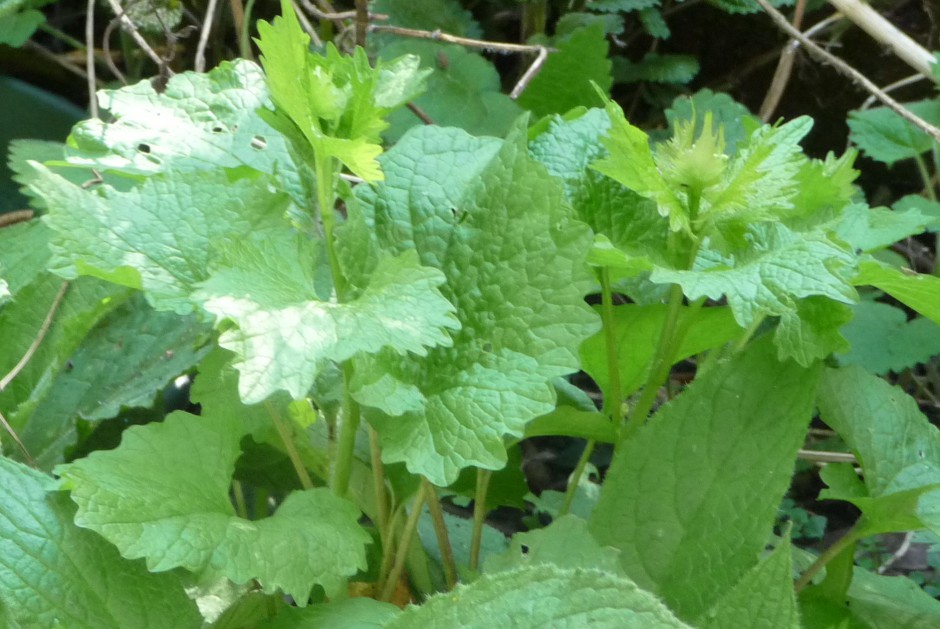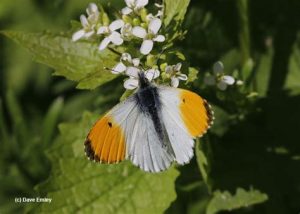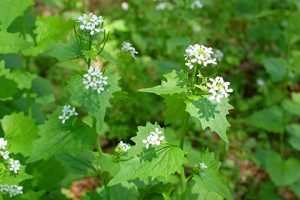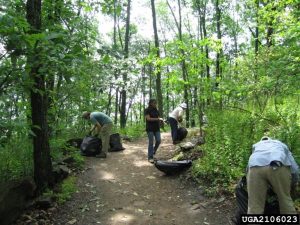GARLIC MUSTARD (Alliaria petiolata)
Europe, NW Africa, Asia
Alliaria petiolata is a biennial wildflower that can be found in grasslands, woodlands, wetlands, hedgerows, towns & gardens.
In its first year the plant puts out a rosette of broad green kidney-shaped leaves. In the spring of its second year, the rosette sends up stems which grow to over a metre in height; the stem leaves are toothed. In April the stems are topped by clusters of small four-petaled WHITE flowers.
The flowers go on until June, when they are followed by pods bearing many tiny seeds, which are easily scattered by wind.
Garlic Mustard is native to Europe, Western and Central Asia, north-western Africa, Morocco, Iberia and the British Isles, north to Northern Scandinavia, and east to northern Pakistan and Xinjiang in western China.
Food for the Orange Tip Butterfly
In the UK, Garlic Mustard is a food plant for the Orange Tip Butterfly. The female Orange Tip tastes the plant with her feet, then lays a single egg. The larva are carnivorous, so each is given its own plant; they feed on the flowers and seedpods.
Edible
“For those who like garlic, but only in moderation, Jack-by-the-Hedge is ideal as a flavouring. When bruised or chopped the leaves give off just a suspicion of the smell of its unrelated namesake… the leaves, finely chopped, can be added to salads.” FOOD FOR FREE, Richard Mabey, Harper-Collins, 2004.
Country people at one time used the plant in sauces, with bread and butter, with salted meat, and with lettuce in salads, hence it acquired also the name of Sauce Alone. The herb, when eaten as a salad, warms the stomach and strengthens the digestive faculties. Maud Grieve, A Modern Herbal 1931
Garlic Mustard has been introduced into the USA & Canada: ‘Good for your weight, heart, lowers cholesterol, may help prevent cancer, with many other health benefits. Flowers, leaves, roots & seeds may all be eaten. But once the weather gets hot leaves will taste bitter.
Flowers can be chopped and tossed into salads. The roots can be collected in early spring and again in late fall, when no flower stalks are present. Garlic mustard roots taste very spicy, somewhat like horseradish. In the fall the seed can be collected and eaten.
Recipes: Chicken Weed Wrap, Fire Cider, Garlic Mushroom Horseradish, Garlic Mustard Pesto, Garlic Mustard Stuffed Mushrooms, Wild Mustard Pesto, Sesame & Wilted Green Saute, Wild Pizza, Wild Roasted Cabbage, Wild Scalloped Potatoes’.
Edible Wild Food, https://www.ediblewildfood.com/garlic-mustard.aspx
Invasive
Invasive plant species can hurt both native plants & pollinators.
In studies (2019) of plants growing together, one pollinator species (West Virginia White Butterfly) used both invasive Garlic Mustard & native toothworts as its host plants. Eggs were laid on both plants. Those laid on Garlic Mustard did not hatch, because the chemical compounds needed for development were not available. A reduced butterfly population was the result.
Pennsylvania Dept of Conservation and Natural Resources https://www.dcnr.pa.gov/GoodNatured/pages/Article.aspx?post=89
Volunteers Fight an Invasive Tide of Garlic Mustard
Ask your computer or device for ‘invasive garlic mustard,’ & many images come up. A UK wildflower making itself unwelcome elsewhere in the world and local volunteers contributing their time and energy to removing it. One interviewer said that Garlic Mustard had been introduced to the USA by a gourmet who put it IN HIS GARDEN in New York in 1869,,, who could have foreseen how invasive it would become?
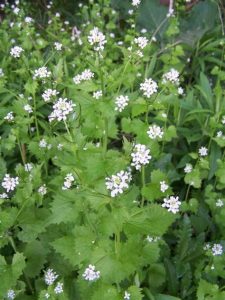
Garlic Mustard Ontario invasive plants th-1099576186.jpg
If you can, volunteer to help in the battle against the invasives. Our volunteers here in North London dealt with invasive Japanese Knotweed while I was with them, but the Garlic Mustard pics here show that we share the experience with so many others. You get a bit of exercise while being part of a team effort in a real battle, & have a great sense of achievement at the end of the day.
Clean renewable energy
For their 2021 Earth Day celebrations, Notre Dame University & the Office of Sustainability converted 500 pounds of veg material from their first annual garlic mustard pull into clean renewable energy via the Grind2Energy System for processing. From Invasion to Energy, Rachel Hughes, Office of Sustainability, May 18, 2021.
Weevil To the Rescue?
Four universities looking for a biological control for invasive Garlic Mustard were hopeful that this tiny European weevil, Ceutorhynchus scrobicollis, might be successful at knocking back the plant’s aggressive spread. The weevil feeds exclusively on Garlic Mustard. That was over a decade ago –
Other names: Alliaria alliaria, Alliaria officinalis, Erysimum alliaria, Garlicwort, Hedge Garlic, Garlic Treacle-Mustard, Garlic Root, Garlicwort, Jack-by-the-Hedge, Jack Run Along by the Hedge, Jack-in-the-Bush, Lady’s Needlework, Mustard-root, Penny Hedge, Poor Man’s Mustard, Sauce-alone, Sisymbrium alliaria, Sisymbrium officinalis. French: Alliare officinale; German: Gemaine Knoblauchsrauche, Italian: Alliaria, Erba Alliaria; Spanish: Ajo Mostaza, Hierba del ajo; Portuguese: Erva-alheira; Netherlands: Look-zonder-look; Sweden: Loektrav.
Garlic Mustard at Highbury
We had Garlic Mustard for several years after buying a plant at an Ecology Centre plant sale. The arrival in the garden of Orange Tip butterflies visiting the plant was always a treat.
2022: We have no Garlic Mustard now, cannot recall how or why it disappeared. Possibly our wildlife pecked up any seeds & foxes, slugs & snails ate the fresh green leaves…

